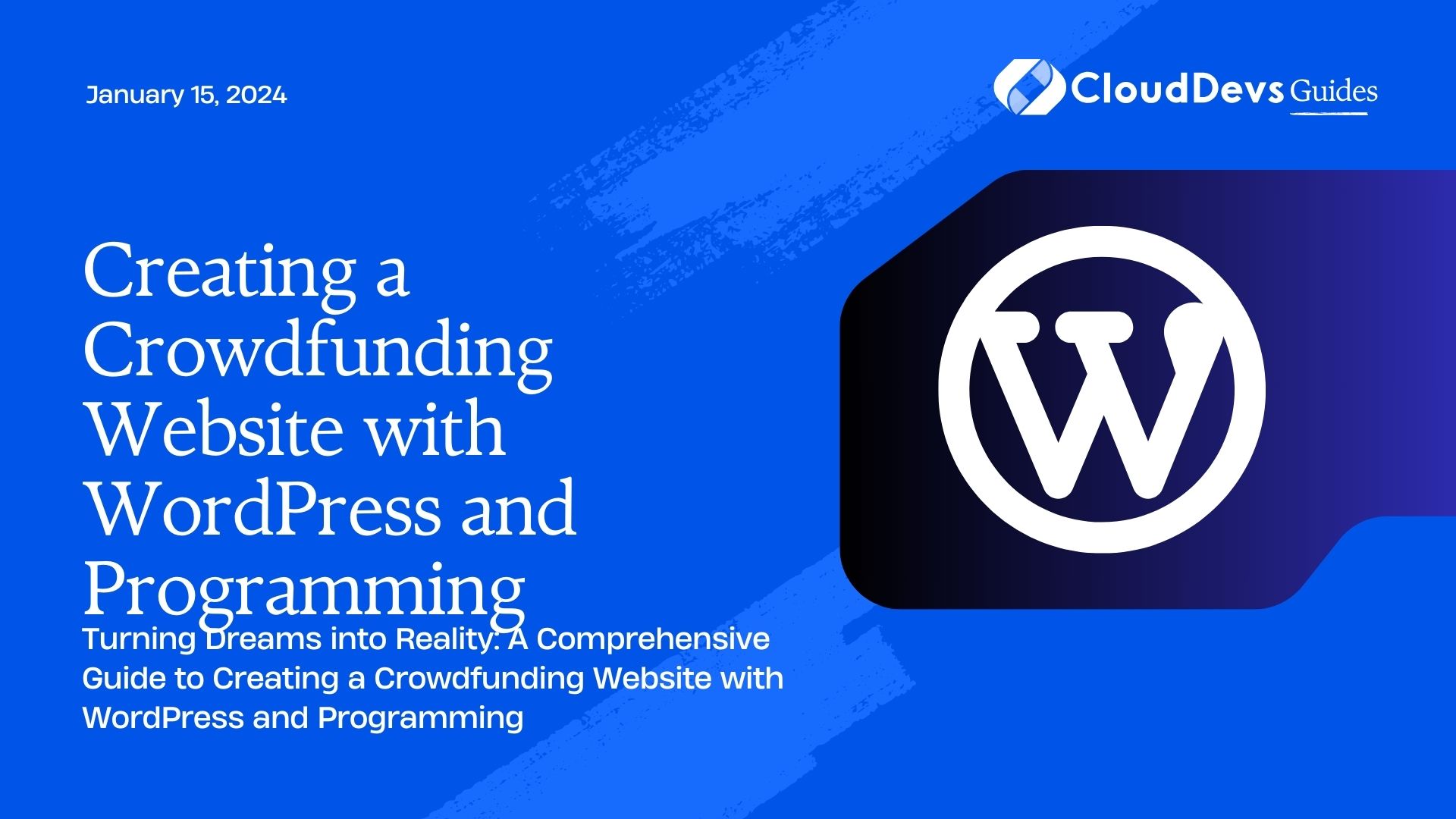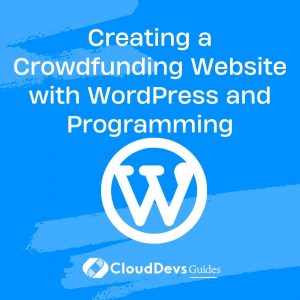Creating a Crowdfunding Website with WordPress and Programming
In today’s digital age, crowdfunding has emerged as a dynamic way to bring innovative ideas to life. Whether you’re an entrepreneur, a creative artist, or a social activist, crowdfunding platforms offer an avenue to fund your projects with the support of a global community. With the growing popularity of crowdfunding, building your own platform can be a rewarding venture. In this comprehensive guide, we’ll show you how to create a crowdfunding website using WordPress and programming.
Table of Contents
1. Why WordPress for Crowdfunding?
WordPress is a versatile content management system (CMS) that powers a significant portion of the internet. Its flexibility, user-friendliness, and extensive library of plugins make it an excellent choice for building a crowdfunding platform. Here are a few compelling reasons why WordPress is a preferred option:
1.1. Open Source and Cost-Effective
WordPress is an open-source platform, which means it’s free to use and modify. This can significantly reduce the development costs of your crowdfunding website.
1.2. User-Friendly Interface
You don’t need to be a coding wizard to manage a WordPress site. Its intuitive interface makes it accessible to individuals with varying technical backgrounds.
1.3. Robust Community and Support
WordPress boasts a vast and active community of developers and users. This means you can find help, resources, and plugins for virtually any functionality you need.
1.4. Scalability
WordPress is highly scalable, allowing your crowdfunding platform to grow as your user base and project count increase.
2. Planning Your Crowdfunding Website
Before diving into the technical aspects, it’s crucial to plan your crowdfunding website meticulously. Here are the steps you should follow:
2.1. Identify Your Niche
Determine the specific niche or category your crowdfunding platform will cater to. This could be anything from tech startups and artistic endeavors to charitable causes.
2.2. Set Clear Goals
Define your website’s objectives. Are you looking to fund creative projects, raise capital for startups, or support charitable causes? Understanding your goals will shape your website’s design and functionality.
2.3. Competitor Analysis
Research existing crowdfunding platforms in your niche. Understand what works well for them and identify areas where you can differentiate your platform.
2.4. Monetization Strategy
Decide how your platform will generate revenue. Common monetization methods include taking a percentage of funds raised, charging listing fees, or offering premium features.
3. WordPress Setup
Now that you’ve laid the groundwork, let’s dive into setting up your crowdfunding website with WordPress. We’ll walk you through the process step by step.
3.1. Domain and Hosting
Start by choosing a domain name that reflects your crowdfunding platform’s identity. Register the domain and select a reliable hosting provider. Popular hosting options for WordPress include Bluehost, SiteGround, and WP Engine.
3.2. WordPress Installation
Most hosting providers offer one-click WordPress installations. Follow their instructions to set up WordPress on your domain.
3.3. Choose a Crowdfunding Theme
Select a WordPress theme tailored for crowdfunding. There are several crowdfunding-specific themes available, such as IgnitionDeck, Backer, and Crowdmerc. These themes come with pre-built templates and features designed for crowdfunding websites.
3.4. Install Essential Plugins
WordPress plugins extend the functionality of your website. To create a crowdfunding platform, you’ll need specific plugins. Here are some essential ones:
3.4.1. WooCommerce
WooCommerce is a powerful e-commerce plugin that integrates seamlessly with WordPress. It allows you to handle financial transactions, making it an ideal choice for a crowdfunding site.
php
// Code sample: Installing WooCommerce
function install_woocommerce() {
$plugin = 'woocommerce/woocommerce.php';
if (!is_plugin_active($plugin) && current_user_can('activate_plugins')) {
$result = activate_plugin($plugin);
}
}
add_action('admin_init', 'install_woocommerce');
3.4.2. Paid Memberships Pro
This plugin lets you manage memberships, which can be useful if you want to offer premium features to backers.
php
// Code sample: Installing Paid Memberships Pro
function install_pmp() {
$plugin = 'paid-memberships-pro/paid-memberships-pro.php';
if (!is_plugin_active($plugin) && current_user_can('activate_plugins')) {
$result = activate_plugin($plugin);
}
}
add_action('admin_init', 'install_pmp');
3.4.3. IgnitionDeck Crowdfunding
This crowdfunding-specific plugin adds essential features like project creation, fundraising goals, and backer rewards.
php
// Code sample: Installing IgnitionDeck Crowdfunding
function install_ignitiondeck() {
$plugin = 'ignitiondeck/ignitiondeck.php';
if (!is_plugin_active($plugin) && current_user_can('activate_plugins')) {
$result = activate_plugin($plugin);
}
}
add_action('admin_init', 'install_ignitiondeck');
Once you’ve installed these plugins, configure them according to your website’s needs.
3.5. Design Your Website
Customize your theme to match your branding and niche. Ensure that your website is user-friendly and visually appealing. A well-designed crowdfunding website can attract more backers.
3.6. Content Creation
Start creating essential pages for your crowdfunding platform:
- Home page
- About us
- FAQ
- Contact
- Terms and conditions
- Privacy policy
Additionally, create a submission page where users can submit their projects for crowdfunding. Use WooCommerce to handle project submissions and backer contributions.
4. Programming Your Crowdfunding Website
While WordPress and plugins can get you a long way, you might need some custom programming to achieve specific features or integrations. Here are some common programming tasks you might encounter:
4.1. Custom Payment Gateway Integration
If you want to use a payment gateway not supported by default, you’ll need to create a custom integration. Here’s a simplified example in PHP for a hypothetical “SuperPay” gateway:
php
// Code sample: Custom Payment Gateway Integration
function superpay_payment_gateway($methods) {
$methods[] = 'WC_Gateway_SuperPay';
return $methods;
}
add_filter('woocommerce_payment_gateways', 'superpay_payment_gateway');
class WC_Gateway_SuperPay extends WC_Payment_Gateway {
public function __construct() {
$this->id = 'superpay';
$this->method_title = 'SuperPay';
$this->title = 'Pay with SuperPay';
$this->has_fields = true;
$this->init_form_fields();
$this->init_settings();
add_action('woocommerce_update_options_payment_gateways_' . $this->id, array($this, 'process_admin_options'));
}
}
4.2. User Dashboard
Create a user dashboard where project creators can manage their campaigns, and backers can track their contributions. You’ll need custom programming to build this feature.
php
// Code sample: User Dashboard (simplified)
function crowdfunding_dashboard() {
if (is_user_logged_in()) {
// Display dashboard content based on user role
} else {
// Redirect to login or registration page
}
}
4.3. Email Notifications
Implement email notifications for various events, such as project updates, new backers, or successful funding. You can use WordPress’s built-in email functions or a plugin like WP Mail SMTP for better email deliverability.
php
// Code sample: Sending Email Notifications
function send_project_update_email($project_id, $message) {
$recipient = get_project_creator_email($project_id);
$subject = 'Project Update: ' . get_project_title($project_id);
wp_mail($recipient, $subject, $message);
}
4.4. Security Measures
Security is paramount when dealing with financial transactions and user data. Implement security best practices, such as data encryption, regular backups, and user authentication.
php
// Code sample: User Authentication
function custom_login() {
// Implement custom login logic
}
add_action('wp_login', 'custom_login');
5. Marketing and Launch
Once your crowdfunding website is up and running, it’s time to attract users and launch your platform successfully.
5.1. Content Marketing
Create valuable and informative content related to your crowdfunding niche. This can include blog posts, video tutorials, and case studies. Share this content on social media and relevant online communities to establish your platform as an authority.
5.2. Social Media Promotion
Leverage the power of social media platforms to reach a wider audience. Regularly post updates about ongoing campaigns, success stories, and behind-the-scenes content.
5.3. Email Marketing
Build an email list and use email marketing to engage with your audience. Send out newsletters, campaign updates, and exclusive offers to your subscribers.
5.4. Paid Advertising
Consider investing in paid advertising to boost your platform’s visibility. Platforms like Google Ads and Facebook Ads allow you to target specific demographics and interests.
5.5. Launch Campaigns
To kickstart your platform, consider launching a few campaigns of your own. This can create a buzz and attract initial backers.
6. Ensuring Legal Compliance
Before you officially launch, ensure that your crowdfunding platform complies with all relevant laws and regulations in your jurisdiction. This may involve:
- Consultation with legal experts
- Drafting clear terms and conditions
- Implementing robust data protection measures
- Understanding tax implications
Conclusion
Creating a crowdfunding website with WordPress and programming is a rewarding endeavor that can empower creators, entrepreneurs, and philanthropists to bring their visions to life. By following the steps outlined in this guide, you’ll be well on your way to launching a successful crowdfunding platform tailored to your niche. Remember, it’s not just about building the site; it’s also about fostering a supportive community and delivering on the promises you make to your backers. Good luck with your crowdfunding journey!
Launching a crowdfunding platform may seem daunting, but with the right tools, knowledge, and determination, you can turn your vision into a reality. So, roll up your sleeves, get coding, and start changing lives through the power of crowdfunding!
Table of Contents








